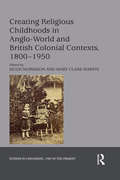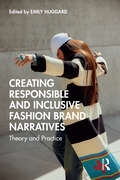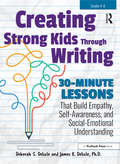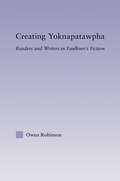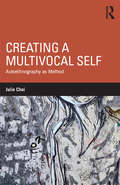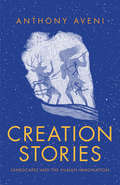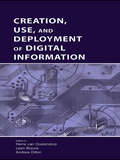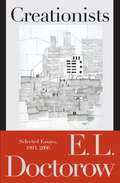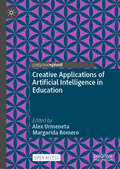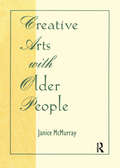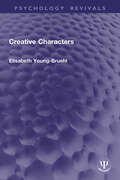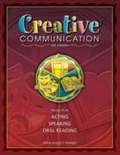- Table View
- List View
Creating Religious Childhoods in Anglo-World and British Colonial Contexts, 1800-1950 (Studies in Childhood, 1700 to the Present)
by Hugh Morrison Mary Clare MartinDrawing on examples from British world expressions of Christianity, this collection further greater understanding of religion as a critical element of modern children’s and young people’s history. It builds on emerging scholarship that challenges the view that religion had a solely negative impact on nineteenth- and twentieth-century children, or that ‘secularization’ is the only lens to apply to childhood and religion. Putting forth the argument that religion was an abiding influence among British world children throughout the nineteenth and most of the twentieth centuries, this volume places ‘religion’ at the center of analysis and discussion. At the same time, it positions the religious factor within a broader social and cultural framework. The essays focus on the historical contexts in which religion was formative for children in various ‘British’ settings denoted as ‘Anglo’ or ‘colonial’ during the nineteenth and early- to mid-twentieth centuries. These contexts include mission fields, churches, families, Sunday schools, camps, schools and youth movements. Together they are treated as ‘sites’ in which religion contributed to identity formation, albeit in different ways relating to such factors as gender, race, disability and denomination. The contributors develop this subject for childhoods that were experienced largely, but not exclusively, outside the ‘metropole’, in a diversity of geographical settings. By extending the geographic range, even within the British world, it provides a more rounded perspective on children’s global engagement with religion.
Creating Responsible and Inclusive Fashion Brand Narratives: Theory and Practice
by Emily HuggardThis book introduces the theories and frameworks necessary to drive meaningful social change in fashion brand communication, illustrating their applications with examples of brands that prioritize social justice, decolonization, and environmental sustainability in their practices and communication strategies.Drawing on social, consumer, and cultural theories—such as Indigenous dress theory, circularity, fat liberation, and social reproduction—this book encourages students to think critically about brand communication in ways that are relevant, impactful, and aimed at transforming discourse and ideologies, rather than focusing solely on products.Through case studies ranging from Polo Ralph Lauren’s collaboration with Indigenous weaver Naiomi Glasses to material regeneration at Veja, the authors demonstrate how these narratives can be applied in practice while raising ethical questions about transparency and authenticity in fashion brand messaging. Readers will not only gain an understanding of why more inclusive and equitable brand narratives are essential but also develop the knowledge and critical thinking skills needed to analyze, interpret, and contribute to the ongoing transformation of fashion brand storytelling.Creating Responsible and Inclusive Brand Narratives will be of interest to advanced students of Fashion Communication, Marketing and Brand Management.
Creating Robust Vocabulary
by Margaret Mckeown Isabel BeckBringing Words to Life has enlivened the classrooms of hundreds of thousands of teachers. Responding to readers' success stories, practical questions, and requests for extended examples, this ideal volume picks up where Bringing Words to Life left off. The authors present additional tools, tips, and detailed explanations of such questions as which words to teach, when and how to teach them, and how to adapt instruction for English language learners. They provide specific instructional sequences, including assessments, for grades K-2, 3-5, 6-8, and 9-12, as well as interactive lesson planning resources. Invaluable appendices feature a quick-reference menu of instructional activities and a comprehensive list of children's books and stories with suggested Tier Two words for study.
Creating Romantic Obsession: Scorpions in the Mind (Palgrave Studies in Literature, Science and Medicine)
by Kathleen Béres RogersMost of us have, at one time, been obsessed with something, but how did obsession become a mental illness? This book examines literary, medical, and philosophical texts to argue that what we call obsession became a disease in the Romantic era and reflects the era’s anxieties. Using a number of literary texts, some well-known (like Mary Shelley’s 1818 Frankenstein and Edgar Allan Poe’s 1843 “The Tell Tale Heart”) and some not (like Charlotte Dacre’s 1811 The Passions and Charles Brockden Brown’s 1787 Edgar Huntly), the book looks at “vigilia”, an overly intense curiosity, “intellectual monomania”, an obsession with study, “nymphomania” and “erotomania”, gendered forms of desire, “revolutiana”, an obsession with sublime violence and military service, and “ideality,” an obsession with an idea. The coda argues that traces of these Romantic constructs can be seen in popular accounts of obsession today.
Creating States: Studies in the Performative Language of John Milton and William Blake
by Angela EsterhammerAlthough the concept of the performative has influenced literary theory in numerous ways, this book represents one of the first full-length studies of performative language in literary texts. Creating States examines the visionary poetry of John Milton and William Blake, using a critical approach based on principles of speech-act theory as articulated by J.L. Austin, John Searle, and Emile Benveniste. Angela Esterhammer proposes a new way of understanding the relationship between these two poets, while at the same time evaluating the role of speech-act philosophy in the reading of visionary poetry and Romantic literature. Esterhammer distinguishes between the 'sociopolitical performative,' the speech act which is defined by a societal context and derives power from institutional authority, and the `phenomenological performative,' language which is invested with the power to posit or create because of the individual will and consciousness of the speaker. Analysing texts such as The Reason of Church-Government, Paradise Lost, The Marriage of Heaven and Hell, and Jerusalem, Esterhammer traces the parallel evolution of Milton and Blake from writers of political and anti-prelatical tracts to poets who, having failed in their attempts to alter historical circumstances through a direct address to their contemporaries, reaffirm their faith in individual visionary consciousness and the creative word – while continuing to use the forms of a socially or politically performative language.
Creating Strategic Readers: Techniques for Developing Competency in Phonemic Awareness, Phonics, Fluency, Vocabulary, and Comprehension
by Valerie ElleryHere Author Valerie Ellery describes a comprehensive literacy classroom, detailing appropriate curriculum, assessment, and instruction. The book includes numerous exciting and engaging techniques geared to students' reading levels and incorporating students' multiple intelligences. This updated, revised, and expanded second edition features: Over 140 classroom-tested techniques 35 new techniques. An expanded focus on educating the whole child A motivation/engagement section for many techniques. An accompanying CD with a wide assortment of reproducibles and assessment forms.
Creating Strong Kids Through Writing: 30-Minute Lessons That Build Empathy, Self-Awareness, and Social-Emotional Understanding in Grades 4-8
by James Delisle Deborah S. DelisleTeachers are always looking for activities that not only enhance the mechanics of writing—grammar, spelling, and syntax—but also allow students to express themselves in creative and personal ways. Creating Strong Kids Through Writing is the perfect resource for teachers seeking quick, ready-to-use writing lessons that encourage social and emotional growth, personal development, introspection, and innovative thinking in students. Each of the 20 lessons has been classroom-tested with students of all ability levels in grades 4-8, and each lesson contains one or more samples of student work to help guide and inspire student writers. Creating Strong Kids Through Writing is a resource teachers will turn to again and again when they seek writing lessons that, although short in duration, are lasting in their personal impact on student growth.Grades 4-8
Creating Television: Conversations With the People Behind 50 Years of American TV (Routledge Communication Series)
by Robert KubeyCreating Television brings television and its creators to life, presenting fascinating in-depth interviews with the creators of American TV. Having interviewed more than 100 television professionals over the course of his 15 years of research, Professor Robert Kubey presents here the 40 conversations that provide the most illuminating insights about the industry and the people working in it. These interviews bring television's creators to life, revealing their backgrounds, work, and thoughts about the audience and the television programs they create. Each interview tells a compelling tale of an individual's struggles and successes within a complex collaborative and highly commercial medium, offering readers rare insights on the human component in television's development. Featured in this volume are actors, agents, writers, directors, producers, and executives, representing television's earliest days through to the present day. Spanning shows from I Love Lucy and The Tonight Show through to Seinfeld, The Simpsons, and The Sopranos, these creators share the stories of how they gained entry to the industry and built their careers, offering readers a rare opportunity to meet, up close, the people involved in creating many of the most famous and successful programs in the medium's history, and linking the creators' personal histories to the television programs they create. With its unique insights on the people responsible for making television, this volume will be of interest to scholars and researchers in television history, sociology of culture, human creativity, television production, media studies, and mass media ethics. It will also be a popular reader for undergraduate and graduate students in courses addressing television, mass culture, media and society, American Studies, creativity, television history, and media ethics.
Creating Texts: An Introduction to the Study of Composition
by Walter Nash David StaceyCreating Texts emphasises a practical approach to composition and enables students to understand what is involved in the creation of a text and to learn from the practice of other writers. Extensively rewritten and updated from Walter Nash's earlier volume, Designs in Prose, attention is paid to the general theory of composition, in both traditional and original terms, so that students are made familiar with the basic resources of composition, in grammar and in the lexicon.The essence of every chapter is the discussion of examples of text, sometimes devised by the authors, but more often drawn from the work of authors writing in diverse styles of English. This practical approach is most evident in the final section of the book where detailed suggestions for projects and exercises reinforce the connection between theory and practice, and encourage students to develop their creative sense and to adapt their style of writing to fit the particular audience and context. In addition, this section is cross-referenced to the main text to allow students to consult easily the relevant chapter.
Creating Unforgettable Characters: A Practical Guide to Character Development in Films, TV Series, Advertisements, Novels & Short Stories
by Linda SegerFrom a longtime script consultant, “a vital aid to all writers, novelists, and screenwriters . . . invaluable” (Gale Anne Hurd, producer, The Walking Dead and Aliens).In this book, Linda Seger, author of Making a Good Script Great, shows how to create strong, multidimensional characters in fiction, covering everything from research to character block. She introduces concepts designed to stimulate the creative process, combining them with practical techniques and exercises. She also offers specific advice on creating nonfiction and fantasy characters, and case studies of such classics as Ordinary People and the sitcom Cheers.Addressing topics from backstory development to character psychology to avoiding stereotypes, Creating Unforgettable Characters is an excellent resource for writers in any genre or creative field. Interviews with successful professional writers complete this essential volume.
Creating Verbatim Theatre from Oral Histories (Practicing Oral History)
by Clare SummerskillOffering a roadmap for practicing verbatim theatre (plays created from oral histories), this book outlines theatre processes through the lens of oral history and draws upon oral history scholarship to bring best practices from that discipline to theatre practitioners. This book opens with an overview of oral history and verbatim theatre, considering the ways in which existing oral history debates can inform verbatim theatre processes and highlights necessary ethical considerations within each field, which are especially prevalent when working with narrators from marginalised communities. It provides a step-by-step guide to creating plays from interviews and contains practical guidance for determining the scope of a theatre project: identifying narrators and conducting interviews, developing a script from excerpts of interview transcripts and outlining a variety of ways to create verbatim theatre productions. By bringing together this explicit discussion of oral history in relationship to theatre based on personal testimonies, the reader gains insight into each field and the close relationship between the two. Supported by international case studies that cover a wide range of working methods and productions, including The Laramie Project and Parramatta Girls, this is the perfect guide for oral historians producing dramatic representations of the material they have sourced through interviews, and for writers creating professional theatre productions, community projects or student plays.
Creating Writers in the Primary Classroom: Practical Approaches to Inspire Teachers and their Pupils
by Miles Tandy Jo HowellTeachers in English schools have now had ten years of prescriptive national literacy strategies and it is time for a new approach. This book encourages children from their early years to think of themselves as writers who have something to write and know how to write it. Creating Writers in the Primary Classroom offers an exciting and refreshing approach to teaching writing in the primary school with very practical suggestions to help build a community of writers in your school where everyone writes and loves writing. Building on the research of recent years and with whole-curriculum provision, it shows teachers how to actively engage children in the writing process, excite them about what they can achieve and help all children to think of themselves as writers. The book begins with a clear analysis of what real writers really need and has chapters on working outdoors, using the very best of children’s literature, drama and imaginative play, as well as sounds and images. It also features a chapter on practical, productive planning, including two case studies that show the approaches in use at schools. Creating Writers in the Primary Classroom is packed with practical advice, games and strategies for the classroom based on the authors’ successful experience as teachers and in-service providers. These new approaches will enable teachers to get their children up and moving, experiencing what writers experience, feeling what writers feel and, most important of all, writing how writers write.
Creating Yoknapatawpha: Readers and Writers in Faulkner's Fiction (Studies in Major Literary Authors)
by Owen RobinsonCreating Yoknapatawpha is a study of the crucial interplay of reading and writing processes involved in constructing the textual environment of William Faulkner’s work, and the nature and significance of the world created by these many forces. Yoknapatawpha County, the author contends, is the product of these mainly mental processes of construction at all levels, and it is in the similar and even analogous situations that exist between readers and writers of and in the fiction that the dynamic of Faulkner’s work is most keenly discovered. The book discusses novels from throughout Faulkner’s career, and uses elements of Bakhtinian and reader-response theory, among others, to explore its subject, eschewing the limited focus both of strictly formal and more content-oriented approaches, and demonstrating the need for readers and writers to work together, whether harmoniously or otherwise. By examining the fictive nature of Yoknapatawpha, and the requirement for everybody to participate fully in its creation, we can establish useful bases for investigations into the ‘real world’ issues with which Faulkner is so concerned.
Creating a Freelance Career
by Jill L. FergusonCreating a Freelance Career covers everything anyone needs to know about becoming a freelance writer, graphic designer, copy editor, artist, musician or any other creative occupation. It includes chapters on how to get started with your career and where to look for work, how to write pitch or query letters, how to work with contract employers, and how to build and sustain your business. Lingo necessary for successfully navigating the freelance world is defined throughout. Author Jill L. Ferguson, an experienced freelance professional and educator, guides you through finding success in the gig economy, discussing how to pursue freelancing with an entrepreneurial spirit. Creating a Freelance Career includes examples of what to do, and what not to do, when pursuing freelance projects, and includes perspectives from additional real-life professionals who have found success in their fields.
Creating a Multivocal Self: Autoethnography as Method
by Julie ChoiShowcasing a new methodology in language learning and identity research, this carefully conceptualized, innovative book explicates the use of autoethnography as a way of re-imagining one’s sense of linguistic and cultural identity. A key work for researchers and students in Applied Linguistics and Language Education, it addresses fundamental aspects of research methodology and explores substantive issues relating to individual dimensions of multilingualism. Choi shows convincingly how the learning of a language is inseparable from one’s constant searching for a voice, a place, and a self in this world, demonstrating the importance of interrogating what lies behind everyday life events and interactions—the political and ethical implications of the utterances, thoughts, actions, and stories of the self and others. Themes of authenticity, illegitimacy, power relations, perceptions of self/other, cultural discourses and practices, and related issues in multilingual identity development surface in the multi-modal narratives. Chapters on methodology, woven through the book, focus on the process of knowledge production, approaches to writing narratives, the messiness of research writing practices, and the inseparability of writing and research.
Creation Stories: Landscapes and the Human Imagination
by Anthony AveniAn accessible exploration of how diverse cultures have explained humanity&’s origins through narratives about the natural environment Drawing from a vast array of creation myths—Babylonian, Greek, Aztec, Maya, Inca, Chinese, Hindu, Navajo, Polynesian, African, Norse, Inuit, and more—this concise illustrated book uncovers both the similarities and differences in our attempts to explain the universe. Anthony Aveni, an award-winning author and professor of astronomy and anthropology, examines the ways various cultures around the world have attempted to explain our origins, and what roles the natural environment plays in shaping these narratives. The book also celebrates the audacity of the human imagination. Whether the first humans emerged from a cave, as in the Inca myths, or from bamboo stems, as the Bantu people of Africa believed, or whether the universe is simply the result of Vishnu&’s cyclical inhales and exhales, each of these fascinating stories reflects a deeper understanding of the culture it arose from as well as its place in the larger human narrative.
Creation, Use, and Deployment of Digital Information
by Herre Van Oostendorp Leen Breure Andrew DillonThe aim of this book is to present results of scientific research on how digital information should be designed and how artifacts or systems containing digital content should maximize usability, and to explain how context can influence the nature and effectiveness of digital communication. Using a philosophical, cognitive, and technical standpoint, the book covers the issue of what digital information actually is. The text also presents research outcomes from the perspective of research in information science--broadly construed--a term now used to cover a range of theoretical and practical approaches.Creation, Use, and Deployment of Digital Information is broken down into three parts:*Part I presents information on how electronic documents can be realized--the complexities, alternatives, functions, and restrictions are treated here.*Part II discusses how human beings process information and how technical solutions can satisfy human restrictions.*Part III treats the context in which digital information processing and deployment takes place.The book has much to offer to academics in many disciplines, including science, the arts, psychology, education, and the information and computing sciences.
Creationists
by E. L. DoctorowE. L. Doctorow is acclaimed internationally for such novels as Ragtime, Billy Bathgate, and The March. Now here are Doctorow's rich, revelatory essays on the nature of imaginative thought. In Creationists, Doctorow considers creativity in its many forms: from the literary (Melville and Mark Twain) to the comic (Harpo Marx) to the cosmic (Genesis and Einstein). As he wrestles with the subjects that have teased and fired his own imagination, Doctorow affirms the idea that "we know by what we create."Just what is Melville doing in Moby-Dick? And how did The Adventures of Tom Sawyer impel Mark Twain to radically rewrite what we know as Huckleberry Finn? Can we ever trust what novelists say about their own work? How could Franz Kafka have written a book called Amerika without ever leaving Europe? In posing such questions, Doctorow grapples with literary creation not as a critic or as a scholar-but as one working writer frankly contemplating the work of another. It's a perspective that affords him both protean grace and profound insight. Among the essays collected here are Doctorow's musings on the very different Spanish Civil War novels of Ernest Hemingway and André Malraux; a candid assessment of Edgar Allan Poe as our "greatest bad writer"; a bracing analysis of the story of Genesis in which God figures as the most complex and riveting character. Whether he is considering how Harpo Marx opened our eyes to surrealism, the haunting photos with which the late German writer W. G. Sebald illustrated his texts, or the innovations of such literary icons as Heinrich von Kleist, Harriet Beecher Stowe, and Sinclair Lewis, Doctorow is unfailingly generous, shrewd, attentive, surprising, and precise.In examining the creative works of different times and disciplines, Doctorow also reveals the source and nature of his own artistry. Rich in aphorism and anecdote, steeped in history and psychology, informed by a lifetime of reading and writing, Creationists opens a magnificent window into one of the great creative minds of our time.From the Hardcover edition.
Creative Applications of Artificial Intelligence in Education (Palgrave Studies in Creativity and Culture)
by Margarida Romero Alex UrmenetaThis open access book explores the synergy between AI and education, highlighting its potential impact on pedagogical practices. It navigates the evolving landscape of AI-powered educational technologies and suggests practical ways to personalise instruction, nurture human-AI co-creativity, and transform the learning experience. Spanning from primary to higher education, this short and engaging volume proposes concrete examples of how educational stakeholders can be empowered in their AI literacy to foster creativity, inspire critical thinking, and promote problem-solving by embracing AI as a tool for expansive learning. Structured in three parts, the book starts developing the creative engagement perspective for learning and teaching to then present practical applications of AI in K-12 and higher education, covering different fields (teacher education, professional education, business education) as well as different types of AI supported tools (games, chatbots, and AI assisted assessment). It also delves into the ethical considerations, policy implications, and the central role educators play in harnessing the power of an AI informed educational experience.
Creative Arts With Older People
by Janice McmurrayWith this insightful and intelligent book, professionals can help institutionalized older adults express themselves creatively. One of only a few books on expressive arts for older people, this unique, new volume is ideal for professionals who provide art activities for residents in adult homes and retirement communities.Creative experience can facilitate the expression of ideas and feelings, increase sensory stimulation, improve self-esteem, and improve social relationships. Creative Arts With Older People provides time-tested suggestions to stimulate the creative process among older adults, resulting in numerous physical, psychological, and social benefits. The author, an artist and a social worker, describes dozens of activities that have proven effective in her many years of working with older people--painting, movement, poetry, sculpting, puppetry, dramatic expression, and more. She explains the goals and advantages of each activity, includes a list of materials needed, and details the step-by-step process for conducting each activity.Creative Arts With Older People is a practical and valuable book for activity directors in adult homes and adult health care units, and workers in adult day care centers, adult psychiatric facilities, and senior centers.
Creative Characters (Psychology Revivals)
by Elisabeth Young-BruehlThe study of creativity is as old as western thought. In recent times any crisis of confidence is likely to involve anxiety about the loss of creativity – scientific, artistic, technological – and to set off a new search for creativity’s definition.In Creative Characters, originally published in 1991, Elisabeth Young-Bruehl reflects on the long search for an understanding of creativity and offers a novel approach. She notes that studies of creativity fall into types. Some look at the act of creation, others focus on the creators, while others stress the conscious or unconscious motivations of creative people. All these approaches share certain limitations. They lack an integrative perspective and they search for a common denominator – one definition of the creative process, a single creative type – which obscures the diversity of creative people and their work.Young-Bruehl here offers an original analysis of creativity based on a theory of character. Creative people, she argues, create in the medium of their characters. They develop (usually unconsciously) an image of their characters or, in other terms, an ideal for the organization of their minds and lives, which they both aspire to and project into whatever they create. This character-ideal appears in their works, their social visions, their philosophies of nature, and also their understandings of creative processes, their own and others’. What creative people wish for themselves, is what they wish for in their lives and works.Young-Bruehl suggests that there are three broad character and creative types, each comprised of many variations. She displays these ways of getting one’s psychic act together or getting a product together by turning to three ancient Greek theorists of creativity – Plato, Aristotle, and Zeno – and three modern theorists – Nietzsche, Freud, and Proust. She then proceeds by clustering biographical vignettes and portraits of ideas in which she can show – rather than try to define – the creativity as well as the character ideal she has in mind.Of special interest to Young-Bruehl is what individuals say about their own creativity, especially when creativity is not explicitly their topic. Her approach is primarily psychoanalytic, but she also uses philosophical analysis, literary criticism, history of science, and biography.Psychoanalysts and psychologists will find the book not only a new approach to creativity, but a new way of doing applied psychoanalysis: there have been many psychobiographies but no effort has been made to survey them and draw conclusions. Philosophers will discover a major contribution to the theory of character, one of the most neglected subfields of philosophy. Finally in Creative Characters biography readers will see how the study of individual lives can lead to reflection on larger questions.
Creative Cognition and the Cultural Panorama of Twentieth-Century Spain
by Candelas GalaThis multidisciplinary study focuses on the creative state as the nucleus of the work of numerous poets, artists, and philosophers from twentieth-century Spain. Beginning with cognitive science, Gala explores the mental processes and structures that underline creative thinking, for poets like Jos#65533; Mar#65533;a Hinojosa, Clara Jan#65533;s, and Jorge Guill#65533;n.
Creative Communication: Projects in Acting, Speaking, Oral Reading
by Fran Averett TannerIn this book, the subjects of public speaking, oral communication, and acting are thoroughly reviewed.
Creative Compassion, Literature and Animal Welfare (The Palgrave Macmillan Animal Ethics Series)
by Michael J. GilmourThis book examines animal welfare themes in fiction, and considers how authors of the last two centuries undermine dominative attitudes toward the nonhuman. Appearing alongside the emerging humane movements of the nineteenth century and beyond is a kind of storytelling sympathetic to protectionist efforts well-described as a literature of protest. Compassion-inclined tales like the Dolittle adventures by Hugh Lofting educate readers on a wide range of ethical questions, empathize with the vulnerable, and envision peaceful coexistence with other species. Memorable characters like Black Beauty and Beautiful Joe, Ivan the gorilla and Louis the trumpeter swan, Hazel and Cheeta, Mr. Bultitude and Doctor Rat do not merely amuse. They are voices from the margins who speak with moral urgency to those with ears to hear. This broad survey of ethical themes in animal fiction highlights the unique contributions creative writers make toward animal welfare efforts.
Creative Composition
by Lori A. May Danita BergFor decades theorists have opined that the lines between creative writing and composition need to be lifted, yet little has been written about the pedagogical methods that allow a cohesive approach between the disciplines. This book brings together contemporary authors and well-respected creative writing instructors and theorists to explore ways creativity in composition may be encouraged in student writers. The question in this anthology is not 'Can writing be taught?' but 'How can we inspire students to embrace the creative process no matter what they write?' This book offers multiple strategies to merge the best practices of teaching writing, regardless of the genre.
